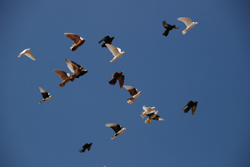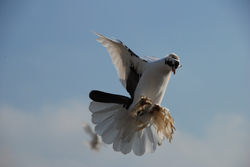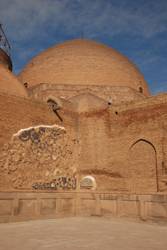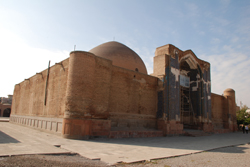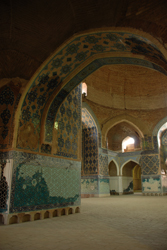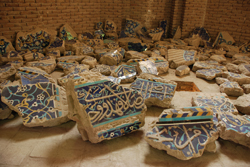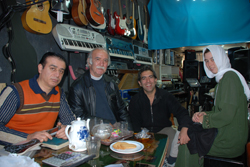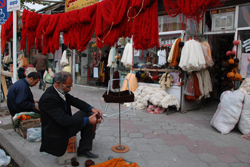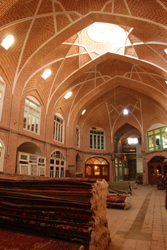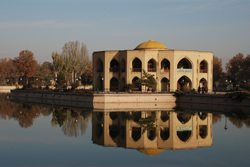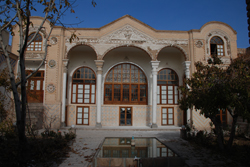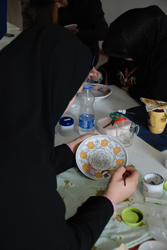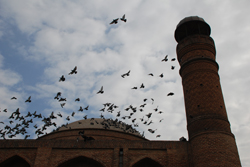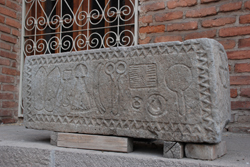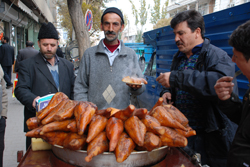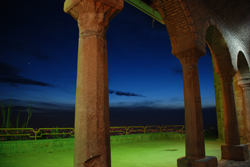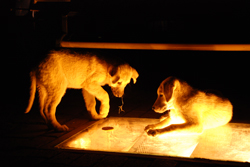Visiting the Sights of Tabriz
13 November, 2008, 02:21 am in "Iran"
Tabriz is cold. It is small, though it does sprawl. The streets have their share of traffic though not nearly as bad as in Tehran. The buildings are mostly brick, probably made from beige and red clay from the surrounding hills. The air is smoggy but sometimes a glimpse of mountains can bee seen through the haze. We drove along the former river bed, past the house where Rowshan was born-- or rather the site of the house. Now the space was covered with large apartment buildings. Rowshan said there used to be only a few houses. Now it was lined with buildings. There was work being done in the dry river bed. I guess they will be building a metro system. Rowshan said even when he was little it was dry except for when it flooded. Later, Rowshan said it was good they were working on it and cleaning because it used to be a place where people dumped their trash. As we were driving through town, we noticed an outdoor equipment store. Rowshan mentioned that Azeris were into hiking more than people from Tehran.
As we wandered around Tabriz, we often saw pigeons circling in the sky. Pigeon-keeping is a popular activity in Tabriz. One of Rowshan's cousins keeps pigeons. The roof of his house contains 3 or 4 pigeon hutches. The pigeons have huge clumps of feathers on their feet so some can barely walk.
The main site in Tabriz is the Blue Mosque which, from the outside, isn't blue at all. We approached from the back, noticing just a tiny patch of blue tile work remaining. The front had more but it was terribly chipped as if someone had gone at it with a hammer.
The inside had more intact sections (just in the lower parts) as well as plaster work showing how the tile work had once looked. At the front was a short bit of information stating the mosque had been extremely damaged during an earthquake. Black and white photocopies showed that it had really just been ruins of the lower parts of the building that remained. In the 70s, the building was reconstructed (and paid for) by a famous Tabriz architect. The dome still had scaffolding on it but that may have been a new thing.
A little down the street from the Blue Mosque was the remains of the Arg, a towered gateway of bricks covered with scaffolding. The whole area was surrounded by construction barricades shielding the new mosque being constructed next to it from the road. Later, one of Rowshan's cousins told us how 27 years ago he remembered the imam at the mosque wanted to destroy the ruins of the Arg to make more room for Friday prayers. The ruins proved so strong they had to blow them up with dynamite. They blew up a section but people were so outraged eventually UNESCO stepped in and made it a World Heritage site saying it belonged to the world and they could not destroy it.
The next stop was one of Rowshan's cousin's music stores. Rowshan wanted to play a joke on his cousin but as soon as he walked through the door of the shop, his cousin recognized him even though he hadn't seen him for 14 years.
The next stop was one of Rowshan's cousin's music stores. Rowshan wanted to play a joke on his cousin but as soon as he walked through the door of the shop, his cousin recognized him even though he hadn't seen him for 14 years.
Rowshan's cousin invited us to his house for lunch. On the way we stopped so he could pick up a couple ingredients. The street was both a yarn seller and butcher street. Skeins of freshly dyed yarn hung outside the shops in cheerful red garlands. Next door hung red cow carcasses.
Another famous site in Tabriz is the bazaar. It is a large brick structure which, when we visited, was very quiet for a bazaar. Perhaps it is busy in the morning. There were rows of gold sellers, another section of carpet sellers and food and spice areas. Tabriz is famous for its carpets.
The Shah Goli Park contains a lake with a concert hall in it and a hill which looks down on Tabriz. Rowshan remembered playing on the hill when it was just unmanicured trees. Now there were paved paths and other park additions.
After that we visited an old Tabriz house with beautiful exterior ganch work and a courtyard with a fountain. This was the home of a ceramics school. Inside was an impressive selection of beautiful ceramics. Some with painted designs based on traditional Persian motives, others with more contemporary designs. There were some beautiful plates with borders of birds made from strips of clay. I thought the pieces were some of the nicest and most original I'd seen in a while. Upstairs a decorating class was in session and we watched women learning to paint a floral and leaf design.
Other historic buildings in Tabriz including the Sahebol Amir Mosque which along with its tomb stones with Persian/Arabic inscriptions had an odd one with scissors, foot shapes and other objects on it. Near the mosque was a labu seller. The cold winter weather makes these hot carmelized turnips a popular item.
For the best view of the city of Tabriz, we went to the Enali Mountain with some of Rowshan's cousins. The cousins asked lots of questions about our travels and thought us very brave. We visited the holy tombs of 2 brothers and sat watching the dark of evening descend and the lights and stars come out. It was getting cold when we left, noting the stray dogs had settled on the inset ground lights in front of a monument to keep warm.
Comments
- Comments
Powered by My Blog 1.69. Copyright 2003-2006 FuzzyMonkey.net.
Created by the scripting wizards at FuzzyMonkey.net..
(Code modified by Rowshan Dowlatabadi)
Created by the scripting wizards at FuzzyMonkey.net..
(Code modified by Rowshan Dowlatabadi)



